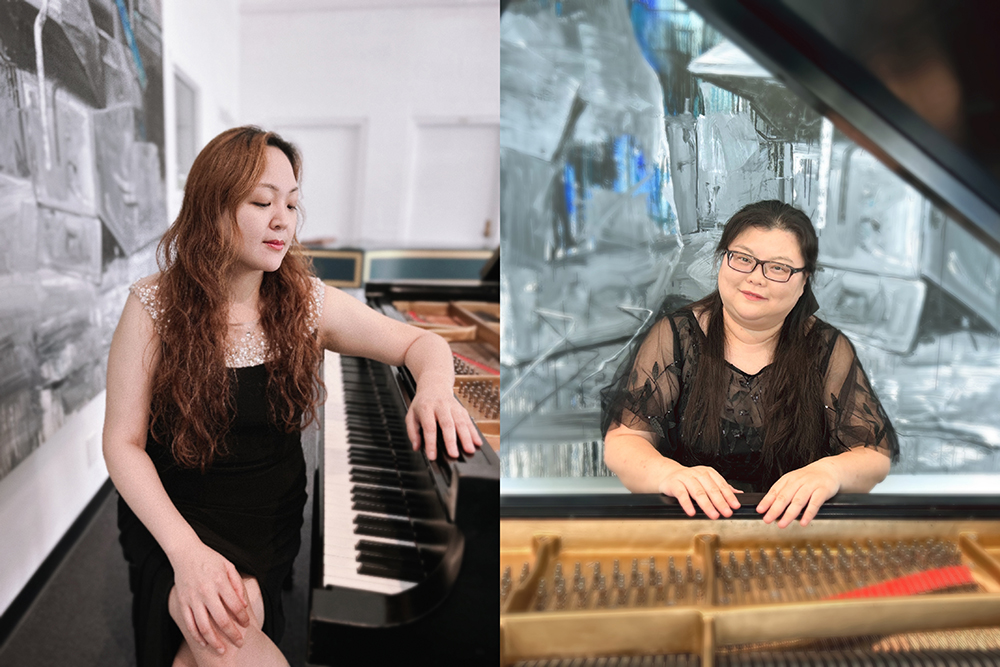The Romantic Grand Duo: Han Na Park & Jieun Kim play works for piano, four hands
Han Na Park, piano, and Jieun Kim, piano, will perform works by Schubert.
Sunday, April 7, 2024, 7 p.m.
Drinkward Recital Hall

Jieun Kim, left, and Han Na Park, right. Photo courtesy of the artists.
PROGRAM
Sonata in B-flat Major for piano, four-hands, D. 617
Allegro moderato
Andante con moto in D Minor, ending in D Major
Allegretto
Allegro moderato
Andante con moto in D Minor, ending in D Major
Allegretto
Franz Schubert
(1797-1828)
(1797-1828)
INTERMISSION
Sonata in C Major for piano, four-hands, D. 812
Allegro moderato
Andante
Scherzo and Trio
Allegro vivace
Allegro moderato
Andante
Scherzo and Trio
Allegro vivace
Schubert
Fantasia in F Minor for piano, four-hands, D. 940
Schubert
Franz Schubert (1797–1828) was an Austrian romantic composer who died at the young age of 31, yet he left behind a prolific body of work, including 600 lieder, nine symphonies and piano sonatas, and various other compositions. Notably, he composed Sonata B-flat Major D. 617 and Sonata C Major D. 812 for piano four hands while at Esterhẚzy.
The Eszterházy is a Hungarian noble family, originating from the Middle Ages, with a rich history of patronage for musicians. Particularly, Franz Joseph Haydn (1732-1809) worked for 30 years under their patronage.
In 1818 Count János Károly Esterházy de Galántha (German: Johann Karl Esterházy von Galánta) hired Schubert as music teacher for his daughters, Mária Terezia and Karoline, during their stay at the family’s summer residence in Zseliz located in rural Hungary at that time. Schubert taught for four months before returning to Vienna. Six years later in 1824, he got hired once again by the Esterházy family. During this time, he fell in love with Karoline, the second daughter of the Esterhazys, who had blossomed into a 19-year-old young lady. Despite their mutual affection, Schubert did not respond to Karoline’s confession of love, and left her with a letter. Nonetheless, Schubert and Karoline maintained a close friendship until Schubert’s death. Despite their relationship, interestingly, Schubert dedicated only one piece of music to Karoline — a four hands piano Fantasy D. 940. Regarding dedication, Schubert’s friend, Schönstein, mentioned in the letter, “when Karoline once jokingly teased Schubert that he had never dedicated a piece of his to her, he responded: 'Why do that? Everything is dedicated to you anyway.'”
These four hands sonatas were composed at Eszterhazy: D. 617 was composed in 1818; and D. 812 was composed in 1824. Sonata D. 617, consisting of three movements composed for Esterhẚzy’s two little daughters, creates a bright and vivid image reminiscent of a lovely thirteen-year-old girl. The sonata opens with a primo part featuring an arpeggio, which seamlessly connects the cadenza-like section into a beautiful theme. Each movement radiates a very bright, light, and cheerful ambience.
Following a six-year interval after his initial visit to Eszterhazy in 1818, Schubert returned to teach music once again. It was during this period that he fell in love with Karoline, which motivated him to compose the four hands Sonata D. 812. Completed in 1824 and published in 1838 under the title “Grand Sonata,” this sonata received commentary from Robert Schumann, who praised it as a “piano version of symphony work.” Sonata D. 812 does not only reveal Schubert’s maturing compositional style and more profound emotional expression in his music; it also incorporates symphonic elements, reflecting his admiration for Beethoven’s symphonies. Consisting of four movements, Sonata D.812 boasts a sense of grandeur characterized by its beautiful melodies.
The first movement begins with a passage that conveys the feeling of exchanging questions and answers, ultimately serving as a pervasive theme throughout the entire movement. The repetition of the theme within the first movement effectively communicates Schubert’s inner turmoil and unresolved self-questioning. The second movement unfolds at a slow tempo, adorned with beautifully lyrical melodies that arouse a profound sense of melancholy and nostalgia. Transitioning to the third movement, we encounter a scherzo that offers a distinctive mood from the preceding trio. While the scherzo emanates humor and vividity, the trio is marked by darker undertones and continuous unstable rhythmic patterns. The final movement encompasses a lengthy coda enriched with numerous symphonic elements. The first theme develops Hungarian dance rhythms, evoking a sense of aimless wandering. On the other hand, the second theme introduces a heroic motif, which reminds us of Beethoven’s works. These two contrasting themes engage in a musical dialogue between the primo and secondo, ultimately culminating in a triumphant resolution.
— Han Na Park & Jieun Kim
Jieun Kim completed her graduate studies at New York University Steinhardt, earning a Master of Music in Piano Performance and an Advanced Certificate in Music Education under Professor Eduardus Halim where she was an adjunct faculty member. Since studying at NYU Steinhardt, she has worked to expand her repertoire, performing as collaborative pianist and as a soloist on the Subway Series (in conjunction with Colombia University), An Evening of Chamber Music at the Black Box Theatre, The Interstudio Showcase at the Frederick Loewe Theatre. Kim recently received her Doctor of Musical Arts (D.M.A) degree in Piano Performance at Claremont Graduate University under Dr. Jenny Soonjin Kim.
HMC is deeply grateful for the generous support that created The Ken Stevens ’61 Founding Class Concert Series.